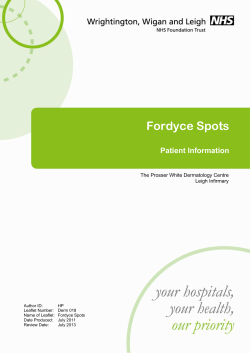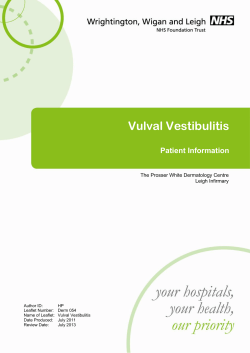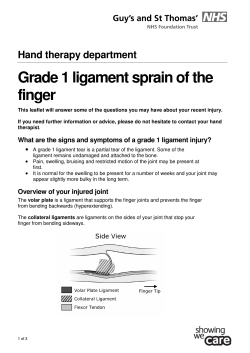
table round
roundtable In association with don’t mention the ‘e’ word Experts debating how to turn plans for huge NHS savings into action raised everything from the managerial skills deficit, to working across boundaries – to the reaction you get from too many staff when you say the word ‘efficiency’. By Daloni Carlisle up the challenge first. He described four levels where there is potential to save: what can be done in your organisation; what can be done locally to change pathways; what can be done collectively by acute providers; and what can be done nationally. “My assessment is that most people have worked very hard at the first level and are running out of road about what they can do in their own organisations. The savings nationally on pay have happened. “We have not, however, made much ground at levels two and three with care pathway redesign, moving care into the community and the pattern of acute provision.” And this is because the system is not geared to make that step change, he added. “The tariff does not support it, the incentives are not geared up and there are medical workforce issues. Francis has made it harder as it has led to loss of confidence in us as leaders and made it difficult to change the face of the service.” His prediction was that by the time changes are made, performance will have dropped in the NHS and some providers 22 Health Service Journal 28 June 2013 will be failing financially. Dr Keith McNeil, chief executive of the Cambridge University Hospitals, took a more practical approach. “From where I sit it is about system alignment and leadership and asking: what do you actively want to provide? A health system or disease treatment?” He did not agree that providers had run out of road, as Mr Farrar put it. “We need to think about productivity,” he said. “We need to look at reducing waste and eliminating unintended variation. That’s where we will get gains.” Yes, said David Loughton, chief executive of Royal Wolverhampton Hospitals, this was a good starting point – except for one thing. “My biggest concern is the management capacity to do anything,” he said. “Managers are spending all their time fire fighting. You become more inefficient as you do that and do not have time to look ahead.” He agreed that Francis could potentially have a negative impact by reducing his flexibility. For example, the trust has now invested several million pounds in making ward Top row, left to right: Mike Farrar, Alastair McLellan, Keith McNeil, Andrew Hawes. Clockwise from bottom right: Jan Filochowski, Paul Mapson, Chris Calkin, James Barlow, David Loughton, Kishamer Sidhu, Ed Burns, Lee Outhwaite, Sandy Bradbrook roundtable participants Jan Filochowski chief executive, Great Ormond Street Hospital David Loughton chief executive, Royal Wolverhampton Hospitals Dr Keith McNeil chief executive officer, Cambridge University Hospitals Kishamer Sidhu finance director, North West London Hospitals Paul Mapson finance director, University Hospitals Bristol Lee Outhwaite director of finance and information, Derby Hospitals Foundation Trust Chris Calkin chair of policy, Healthcare Financial Management Association Mike Farrar chief executive, NHS Confederation Professor James Barlow Imperial Business School Sandy Bradbrook senior adviser to Newton Europe Ltd Andrew Hawes director, Newton Europe Ltd Ed Burns associate director, Newton Europe Ltd Alastair McLellan editor, HSJ hsj.co.uk wilde fry Understanding and accepting the scale of the financial challenge in the NHS has been tough. Drawing up the strategies to deliver savings has been painful. Now comes the hardest part of all: turning strategy into action. This was the topic of a roundtable debate convened by HSJ and supported by Newton Europe Limited. Around the table were chief executives and finance directors as well as policy leaders. Alastair McLellan, HSJ editor, set the scene. “In theory, the onus now is on the service to make change such as moving care to the community,” he said. “But there also has to be an expectation that provider organisations are able to do more for less. “Sounds simple,” he said. “In reality it is a lot more complex than that description provides. We can all point to ideal scenarios that may or may not come about but there is a very real challenge in the NHS for the next two years. What has to be done and how should it be done?” Mike Farrar, chief executive of the NHS Confederation, picked hsj.co.uk 28 June 2013 Health Service Journal 23 working lives, not as a big project.” Kishamer Sidhu, finance director at North West London Hospitals, raised another leadership and management issue. The hard work to squeeze out efficiencies, now compounded by Francis, is leading to fragmentation within the workforce. “People are starting to break off into different tribes,” he said. “They are trying to find ways to defend their own areas and moving away from doing anything together. That is the greatest ‘When they tried to implement redesign we found a lack of will because if I win then you lose’ challenge we face.” Mr Filochowski agreed that successful savings plans required support from staff – but after two years of hard graft they were tired. “If organisations believe it is doable they will get behind it. But if they are tired and they don’t believe it is possible, then it is a worry.” Clinical engagement was a running theme of the debate. Sandy Bradbrook, a former NHS chief executive and now senior adviser to Newton Europe, said: “I believe there is still scope to make efficiencies, and the key thing is getting clinicians involved as they are the ones who run the processes.” Dr McNeil, however, argued that managers must abandon the word “efficiency” if they were to engage clinicians: “Clinicians are really important. But if you use that word ‘efficiency’ we will run a mile.” Chris Calkin, head of policy for the Healthcare Financial Management Association, wanted to know why. Surely we all wanted to work for an efficient organisation, he said. “Why is it such a no-go area?” Mr Loughton countered: “I never talk about money in my organisation ever. I talk about quality and about reducing deaths. That is the currency that I talk to clinicians in. Talking about money motivates no one.” Mr Filochowski agreed that language matters. Clinicians are frustrated by waste and 26 Health Service Journal 28 June 2013 inefficiency but see its impact in terms of how it affects their jobs and their patients– why did they have to wait 30 minutes for the patient in theatre when there was a porter standing idle? “You need to avoid theology and get down to specifics,” he said. We say ‘no harm, no waste, no waits’.” Others agreed that the whole language of savings needed reframing. Lee Outhwaite, director of finance and information at Derby Hospitals, said: “The big scary view of the world [if we don’t make savings] is not particularly helpful. We need to think about how we recycle resource from where it is not adding value to where it does add value.” Mr Bradbrook argued that clinical commissioners may start to drive both engagement and redesign. Mr Calkin said this was good in theory. But he had recently worked in one local health economy where all the providers and commissioners had sat round the table doing brilliant redesign work but failed to deliver. “When they started to try to implement it we found a lack of will because if I win then you lose,” he said. “There is nothing in the system they could see that would mitigate that.” He also picked up on Mr Farrar’s third level and argued that providers needed to start making strategic alliances to decide who was best placed to do what and how to create critical mass to make services sustainable. This might run against policies on plurality, and would be intensely political. Trusts needed both guidance on the former and informed local political leadership on the latter. The debate so far was predicated on the idea that the NHS was aiming at the right target. Paul Mapson, finance director of University Hospitals Bristol, took a different view. He argued that 4 per cent savings were not tenable. He had surveyed trusts and found that they were not delivering on their strategies to generate one third of savings through pay, one third through non-pay measures and one third through income. The scenario post-Francis was that savings made in the past were now being unwound. He said: “If we plan on 4 per cent we are just kidding ourselves. If we plan on 2 per cent savings it is doable but the macroeconomics do not work and it will mean we cannot do everything. That creates a different debate.” Returning to Mr Farrar’s analysis, there was widespread agreement that the financial situation would worsen in the near future, driven largely by an increase in emergency work. With trusts getting below tariff for excess emergency work and then being hit with the double whammy of loss of elective income, the figures would soon tip out of balance. Mr Mapson summed up several comments when he said: “You cannot be productive in a clinical environment if you have constant cancellations of your elective work. This needs a rethink but it is very political.” The roundtable also agreed that local pay was not a route to make savings. It had been tried and failed in the southwest, said Mr Mapson. Mr Loughton added that it was not the time to “hit your staff ” already facing a financial squeeze at home. He had recently been persuaded against his better judgement to raise car parking fees for the first time in five years to 7p an hour, raising £1m. “At a stroke I have peed off 9,000 people,” he said. Others took a macroeconomic view, warning that cutting pay for NHS staff would impact the wider economy, or argued that NHS organisations lacked the management skills and capacity for local pay. Professor James Barlow, chair in technology and innovation management, confessed he was depressed by the debate so far. “We have heard all this before and we know the diagnosis and we know what the solutions are,” he said. “I think there are two things we need to discuss. Who is going to drive change locally in an increasingly fragmented system and what will the impact be of the health, wealth and innovation agenda?” Mr McLellan then asked the participants for their solutions. For Dr McNeil it was a case of unblocking the system through process redesign and system reform. “We need to pool resources and use the health pound to unblock the system,” he said. Rehabilitation, better social care and delivering services such as palliative care at home were top of his list. Mr Loughton would put his money in better management of community services to reduce hospital length of stay, including developing teams that worked across settings for people with In association with Clockwise from bottom: Alastair McLellan, Keith McNeil, Kishamer Sidhu, Ed Burns, David Loughton conditions such as stroke. Mr Hawes argued for focused work around theatre and outpatient efficiency, where Newton Europe’s work – not least at Royal Wolverhampton Hospitals – had shown that multimillion pound savings were possible. Mr Sidhu said outsourcing pathology was a clear winner in his area – but only because clinical commissioning groups had been actively involved in managing the transition to avoid destabilisation. Mr Bradbrook pointed to the Sandwell RAID initiative, where mental health teams in emergency departments divert patients to more appropriate settings. “It took nine months to establish but within another nine months the hospital had closed 60 beds without any fuss.” It is now being rolled out across Birmingham. In Derby, the big conversation was “how do you work outside your own organisation and what do you do on the integration agenda,” said Mr Outhwaite. “How do you work with your neighbouring DGH?” He looked forward to explaining this to the European competition regulators, he joked. Mr Filochowski’s focus was on avoiding delays and blockages by creating ways to release patients who no longer needed your care. He also wanted to see better use of capital and buildings and more accurate pricing. “If we paid what it cost for emergency admissions, it would really help.” Mr Mapson returned to the theme of management capacity. Too many hospitals brought in management consultants at £1,200 a day who made recommendations that were handed to managers on £200 a day who then failed to achieve. “It is often because they are not trained to do it,” he said. “Our middle managers are at their lowest ebb and I would like to see something done nationally to invest in their skills.” Mr Hawes said that the better consultancies did not just hand out recommendations. “It is not the bright ideas that make efficiencies. It’s the genius behind making things happen that counts.” Mr Calkin said that clinicians needed better information to be efficient. “The junior doctor in A&E who sees the 85 year old at 3pm on a Sunday afternoon admits the patient because they have no idea that there is a social care plan or a neighbour who could help and they do what is safe. Information for clinicians would really help.” Professor Barlow wanted to see better metrics and better use of locally set targets. “I know it is a dirty word but intelligent, local and contextually specific targets really can drive behaviour change.” Mr Burns agreed: “We need to use information not just to review performance but also to drive it. Giving people information about what is happening in theatres tomorrow or next week to help them look forward as well as back.” Taking an overview, Mr Farrar raised overall resourcing: “People have to act locally to re-interrogate separate budget strands. We need to look at the total resource available and discuss how much we have and how we can best use it.” He also wanted to plan to avoid rather than wait for failure. “The failure regime is costing the taxpayer millions and it does not work,” he said. “You need to plan at local level how to share services. If you wait for failure all you do is accelerate the rising level of debt.” Mr McLellan then raised two issues, one that had come up in discussion and one that had not. First, would the panel welcome competition from new entrants to the market? Mr Loughton joked that he would “love someone to compete with me for emergency work – they can have as much as they like”. More seriously, though, there was no antipathy to new providers, especially in niche areas such as community services and telehealth, or through better working with the voluntary sector. There was even discussion of splitting acute work into “hot” and “cold” sites. The other issue was technology. Mr McLellan was surprised it had not been mentioned. An equivalent group in the US might have looked to IT early on for solutions. Professor Barlow countered: “Technology is fine but embedding it is 90 per cent of the task. Yes, it can improve efficiency and productivity but it often also drives up costs because it allows you to do more.” For this group, moving from strategy to action is already happening. It is hard, and it will require some national guidance and action, particularly on plurality, the tariff and emergency care. But it is, they think, just about doable. l 28 June 2013 Health Service Journal 25 wilde fry roundtable managers supernumerary. “So there are now large parts of the workforce you cannot touch.” But Mr Loughton saw scope for more savings and was optimistic. Centralising pathology services was a promising area as was making better use of community services, which form part of his trust. “We have set a target of 300 fewer people dying in hospital this year and that will start to take the pressure off.” Jan Filochowski, chief executive of Great Ormond Street Hospital, said: “I would go further than David and say not only are there areas we cannot touch but there are areas where we need to invest to make improvements. That’s hard.” His trust had increased income from overseas patients by nearly 5 per cent last year. “We cannot do this every year as we need room for NHS patients,” he noted. But he was sceptical about large-scale improvements such as pathology, which he said, “create mayhem”. “Where there is a huge amount of money to be saved is at the boundaries between organisations,” he added. GOSH regularly has a situation where it cannot take patients into ITU because it is full but cannot discharge patients to ITU in district general hospitals because they are full of people in acute beds who do not need to be there but cannot be discharged. “It is part of the myth that we have to run hospitals at 100 or 105 per cent capacity. It just increases inefficiency,” he said. Andrew Hawes, director of Newton Europe, supported Mr Loughton’s concerns about management. “There is a skills and capacity gap in middle management, partly because of the history of the last 12 to 15 years and this is the biggest challenge that the acutes are facing,” he said. “We are miles away from running out of road in terms of inefficiencies in the acute sector.” His Newton colleague Ed Burns added: “There are still inefficiencies in organisations, but they are very hard to see because they are all about how patients move through the hospital or in and out of outpatients. They are also difficult to change. “We need to get the right visibility and the right metrics and empower people to change and to do it as part of their
© Copyright 2025













